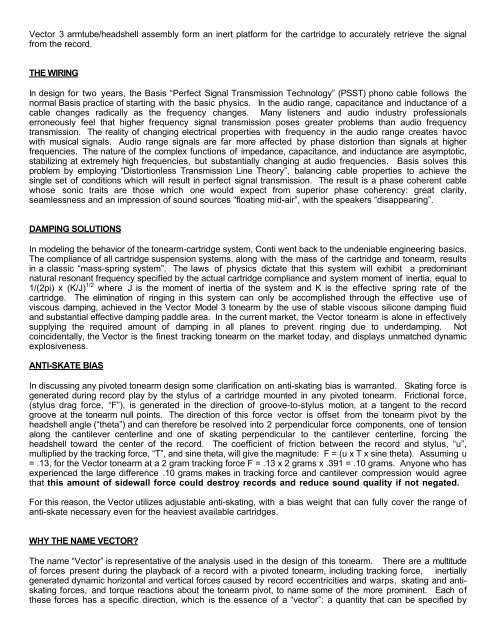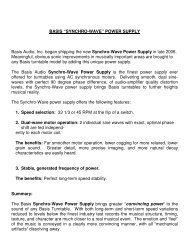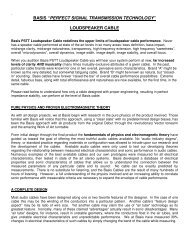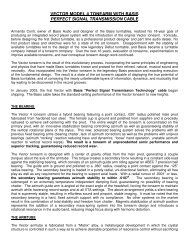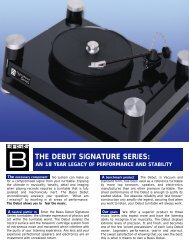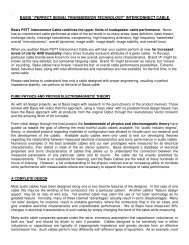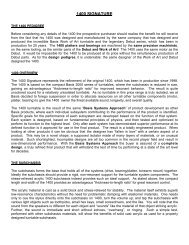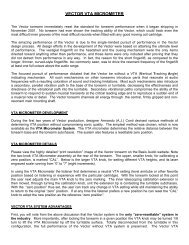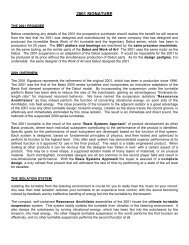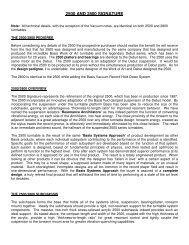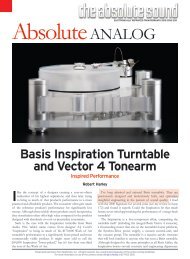vector model 3 tonearm with basis perfect signal ... - Basis Audio
vector model 3 tonearm with basis perfect signal ... - Basis Audio
vector model 3 tonearm with basis perfect signal ... - Basis Audio
You also want an ePaper? Increase the reach of your titles
YUMPU automatically turns print PDFs into web optimized ePapers that Google loves.
Vector 3 armtube/headshell assembly form an inert platform for the cartridge to accurately retrieve the <strong>signal</strong>from the record.THE WIRINGIn design for two years, the <strong>Basis</strong> “Perfect Signal Transmission Technology” (PSST) phono cable follows thenormal <strong>Basis</strong> practice of starting <strong>with</strong> the basic physics. In the audio range, capacitance and inductance of acable changes radically as the frequency changes. Many listeners and audio industry professionalserroneously feel that higher frequency <strong>signal</strong> transmission poses greater problems than audio frequencytransmission. The reality of changing electrical properties <strong>with</strong> frequency in the audio range creates havoc<strong>with</strong> musical <strong>signal</strong>s. <strong>Audio</strong> range <strong>signal</strong>s are far more affected by phase distortion than <strong>signal</strong>s at higherfrequencies. The nature of the complex functions of impedance, capacitance, and inductance are asymptotic,stabilizing at extremely high frequencies, but substantially changing at audio frequencies. <strong>Basis</strong> solves thisproblem by employing “Distortionless Transmission Line Theory”, balancing cable properties to achieve thesingle set of conditions which will result in <strong>perfect</strong> <strong>signal</strong> transmission. The result is a phase coherent cablewhose sonic traits are those which one would expect from superior phase coherency: great clarity,seamlessness and an impression of sound sources “floating mid-air”, <strong>with</strong> the speakers “disappearing”.DAMPING SOLUTIONSIn <strong>model</strong>ing the behavior of the <strong>tonearm</strong>-cartridge system, Conti went back to the undeniable engineering basics.The compliance of all cartridge suspension systems, along <strong>with</strong> the mass of the cartridge and <strong>tonearm</strong>, resultsin a classic “mass-spring system”. The laws of physics dictate that this system will exhibit a predominantnatural resonant frequency specified by the actual cartridge compliance and system moment of inertia, equal to1/(2pi) x (K/J) 1/2 where J is the moment of inertia of the system and K is the effective spring rate of thecartridge. The elimination of ringing in this system can only be accomplished through the effective use ofviscous damping, achieved in the Vector Model 3 <strong>tonearm</strong> by the use of stable viscous silicone damping fluidand substantial effective damping paddle area. In the current market, the Vector <strong>tonearm</strong> is alone in effectivelysupplying the required amount of damping in all planes to prevent ringing due to underdamping. Notcoincidentally, the Vector is the finest tracking <strong>tonearm</strong> on the market today, and displays unmatched dynamicexplosiveness.ANTI-SKATE BIASIn discussing any pivoted <strong>tonearm</strong> design some clarification on anti-skating bias is warranted. Skating force isgenerated during record play by the stylus of a cartridge mounted in any pivoted <strong>tonearm</strong>. Frictional force,(stylus drag force, “F”), is generated in the direction of groove-to-stylus motion, at a tangent to the recordgroove at the <strong>tonearm</strong> null points. The direction of this force <strong>vector</strong> is offset from the <strong>tonearm</strong> pivot by theheadshell angle (“theta”) and can therefore be resolved into 2 perpendicular force components, one of tensionalong the cantilever centerline and one of skating perpendicular to the cantilever centerline, forcing theheadshell toward the center of the record. The coefficient of friction between the record and stylus, “u”,multiplied by the tracking force, “T”, and sine theta, will give the magnitude: F = (u x T x sine theta). Assuming u= .13, for the Vector <strong>tonearm</strong> at a 2 gram tracking force F = .13 x 2 grams x .391 = .10 grams. Anyone who hasexperienced the large difference .10 grams makes in tracking force and cantilever compression would agreethat this amount of sidewall force could destroy records and reduce sound quality if not negated.For this reason, the Vector utilizes adjustable anti-skating, <strong>with</strong> a bias weight that can fully cover the range ofanti-skate necessary even for the heaviest available cartridges.WHY THE NAME VECTOR?The name “Vector” is representative of the analysis used in the design of this <strong>tonearm</strong>. There are a multitudeof forces present during the playback of a record <strong>with</strong> a pivoted <strong>tonearm</strong>, including tracking force, inertiallygenerated dynamic horizontal and vertical forces caused by record eccentricities and warps, skating and antiskatingforces, and torque reactions about the <strong>tonearm</strong> pivot, to name some of the more prominent. Each ofthese forces has a specific direction, which is the essence of a “<strong>vector</strong>”: a quantity that can be specified by


